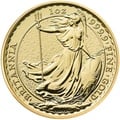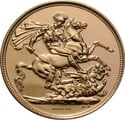Gold currency
A gold currency is defined as a legal tender coin or token that holds value based on the gold exchange rate. Gold currencies originate from times when coins were made from precious metals. The value of gold coins in historic currencies was based directly on the metals they contained and not fixed on their face value. This was more commonly referred to as the gold standard, and globally this was officially abandoned in 1971.
As trade and commerce expanded across the globe it was deemed no longer feasible to maintain this direct physical link in values with the price in gold, and the physical metal value of a coin became separated from its
face value.
Gold backed currency
Like many other currencies, the British Pound Sterling was fixed to an amount of gold or silver. This principle was in place between 1717 and 1931.
Starting in the 1850s, this was internationally termed the Gold Standard Exchange mechanism. This international system was disrupted by the First World War, and struggled to continue afterwards.
After the Great War there were international attempts to re-establish the Gold Standard. In 1925, Britain again pegged its currency to gold price charts. Many economists cite this and similar actions as a possible cause of the 1930s 'Great Depression'. Consequently, in 1931, the UK government issued the Gold Standard Amendment Act, which ended the arrangement until the end of the Second World War.
Following the Second World War, the victorious Allied nations met at
Bretton Woods
in the United States. Here a new international financial system was established.
Bretton Woods, site of the 1944 Conference which led to the establishment of the International Monetary Fund.
America's prosperity and limited involvement during the First World War had put it in an exceptionally strong position financially. Even with its heavy involvement late into the Second World War, the US economy was still the world's powerhouse. The meeting in 1944 saw the US effectively replace the UK as the world's financial starting point. Under the Bretton Woods agreement the value of major currencies were fixed to the US Dollar. In turn, the Dollar was pegged to the spot price of gold. Initially, the US treasury guaranteed to exchange 35 Dollars to the ounce for gold.
The International Gold Standard Exchange mechanism and its derivative, which was established at Bretton Woods, officially ended in 1971 at the behest of President Nixon. The US Treasury abandoned its guarantee to exchange US Dollars for gold, and from this time national currencies have been valued against each other. Currencies were subsequently described as being fiat currencies as opposed to gold currencies.
The age of the gold backed currency is now over, with no major global economies operating on this type of monetary system. Despite this, refineries around the world continue to mint gold bullion coins with a face value, although these are purely for investment purposes. These coins are deemed legal tender due to their face values, but these valuations are much less than the value of their gold. The upside, however, is that by being 'legal tender' these coins enjoy tax advantages over gold bars.
As pure gold bullion investments, coins act as a safe haven store of wealth and can diversify a portfolio. They are also free from counterparty risk of bank or government actions. To this day there are still calls for the gold backed currencies of yesteryear to return. At present however, investors and collectors continue to enjoy the gold currency coins produced around the world.
Digital gold currencies
As an alternative to fiat currencies, the modern era has seen the introduction of 'digital' currencies, such as Bitcoin. One aim of these digital currencies is to rival investment bullion, but without the need to physically hold metal.
With fears about the stability and security of these digital currencies, few have so far proved a stable investment. Some digital currencies are even returning to gold. New 'Digital gold currencies', or DGCs, are digital currencies that represent shares in physical gold. These allow buyers to invest in small units of gold plus avoid issues of storage and insurance. They do, though, reintroduce a counterparty risk, as investors must rely on the electronic provider.
For investors seeking reassurance of a gold backed currency, the best equivalent today is provided by gold bullion coins.
- How To Buy Gold
- How to Buy?
- Payment Options
- Delivery Options
- Gold Storage
- Storage at Brink's
- Gold Investment Guide
- Why buy gold?
- Is gold a good investment?
- Why physical gold?
- Best time to buy gold?
- Gold bars vs coins?
- Gold vs Silver
- Gold - Silver Ratio explained
- VAT on bullion
- CGT on bullion
- Legal tender coins
- Top 5 Gold Investments
- Top 5 Silver Investments
- Gold vs ISAs
- Gold vs Buy-to-Let
- Gold vs FTSE 100
- Gold vs Bitcoin
- Where to buy gold?
- Why buy from us?
- Where to sell gold?
- Coin Shops
- Gold Price Forecasts
- Top 10 Gold Producers
- Top 10 Gold Reserves
- Gold Britannia vs Sovereign
- Britannia coin designs
- Sovereign coin designs
- Sovereign Mintages
- Sovereign mint marks
- British coin specs
- What is a proof coin?
- Royal Mint bullion
- The Queen's Beasts
- Royal Mint Lunar Coins
- Bullion Refiners
- British coin mints
- Krugerrands
- Gold Tola - India & Pakistan
- Bullion Index










